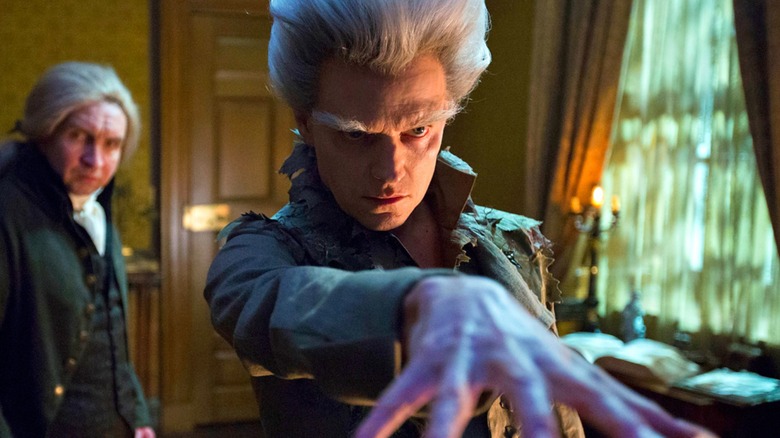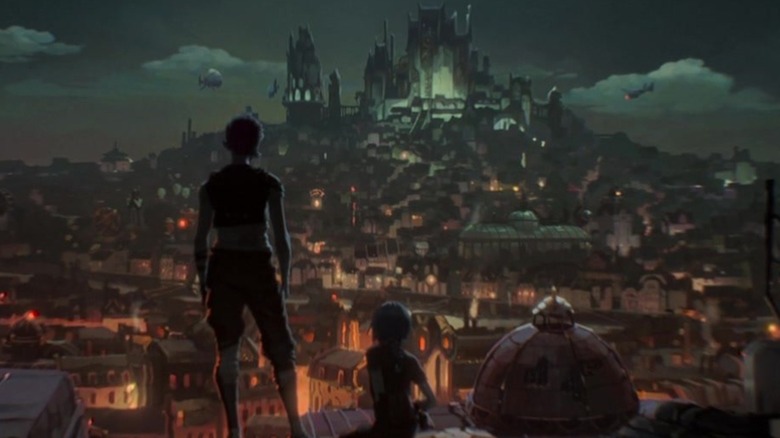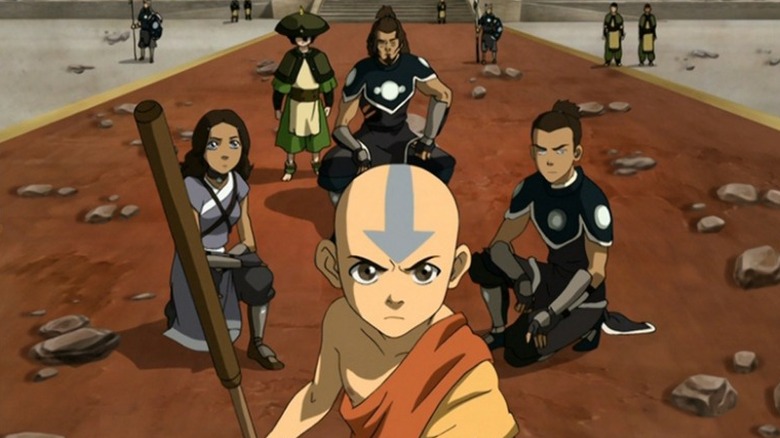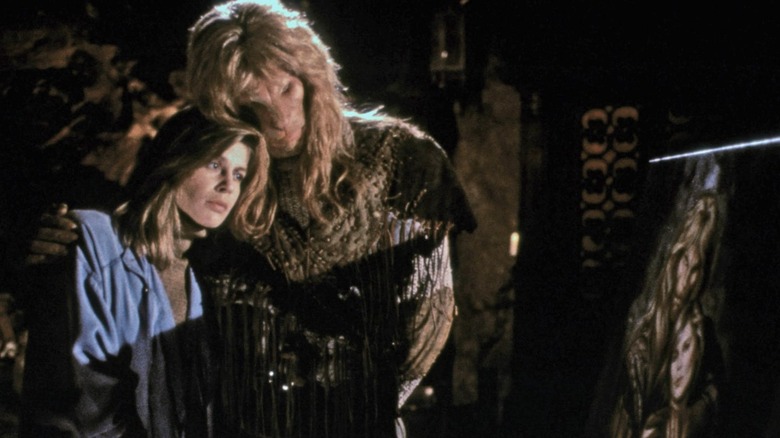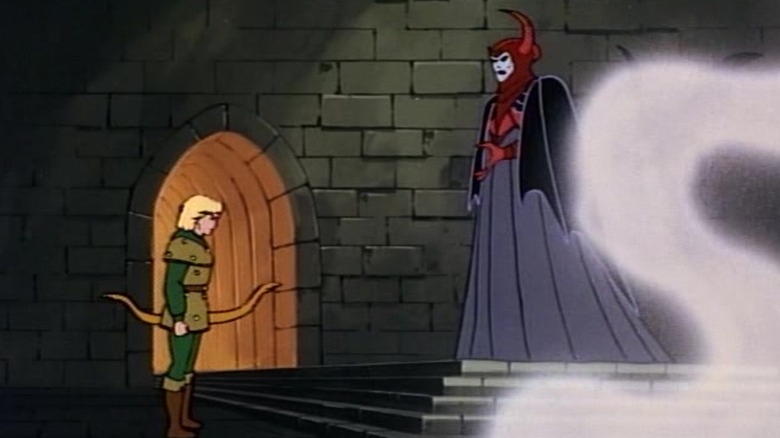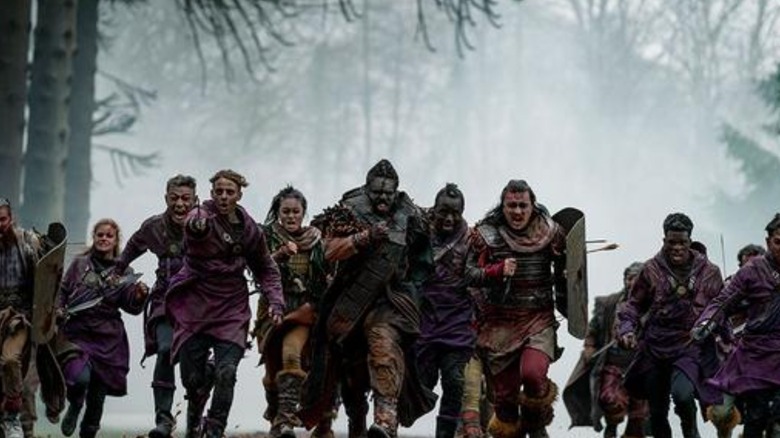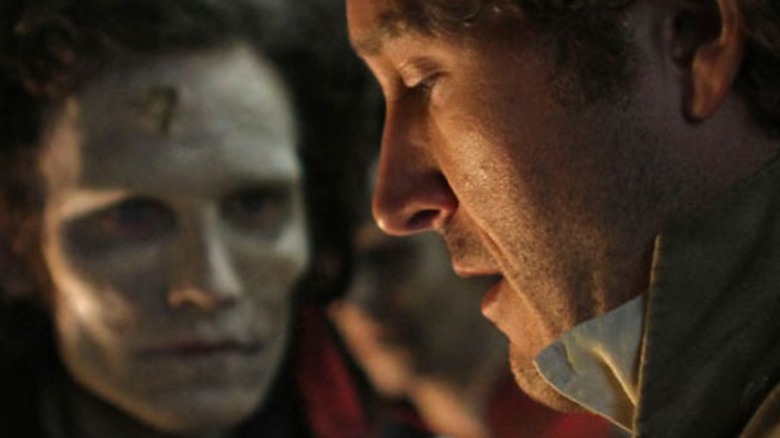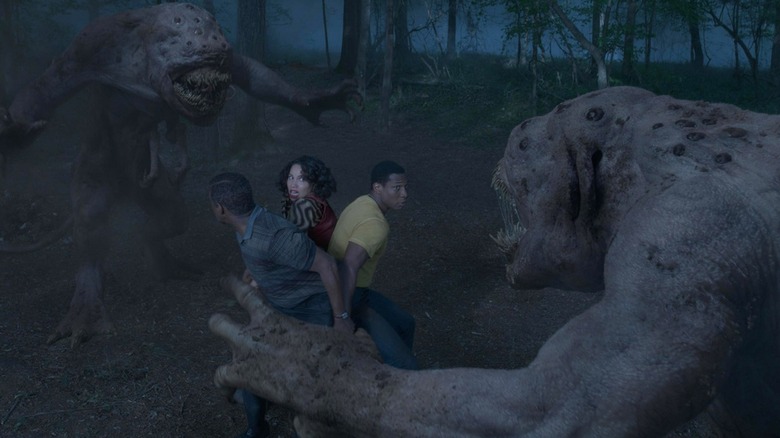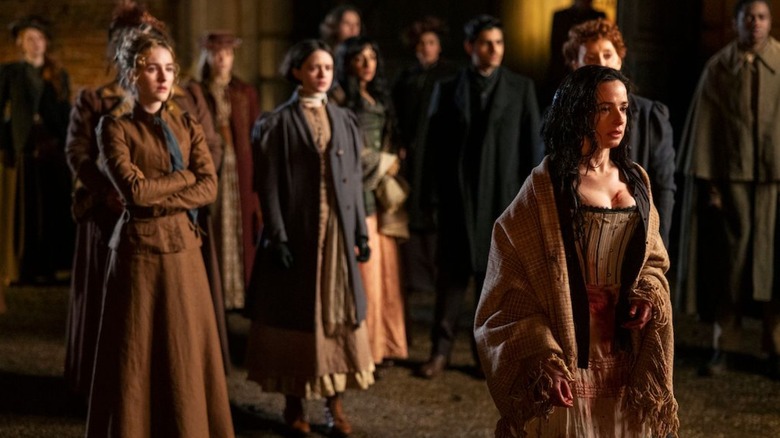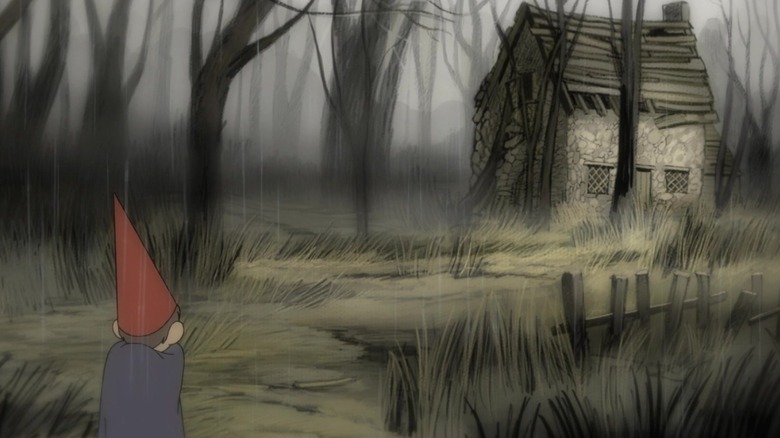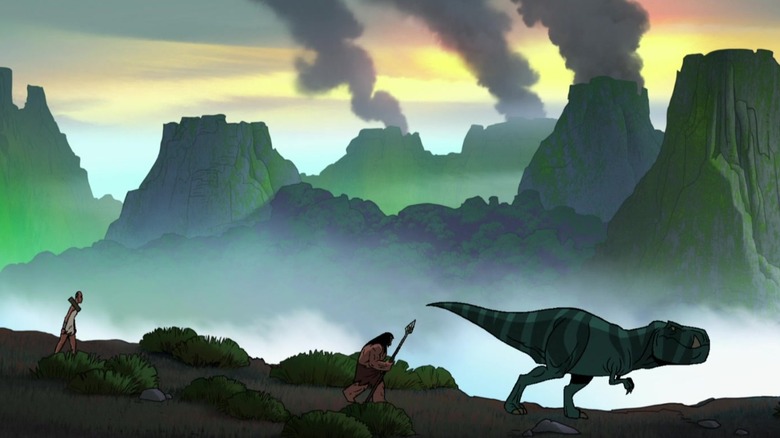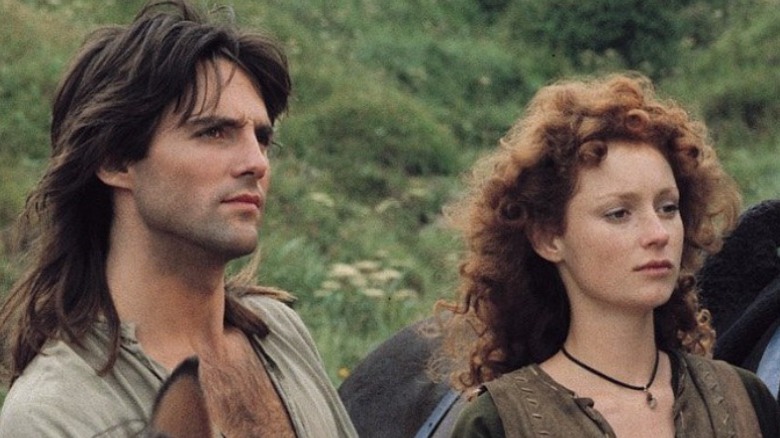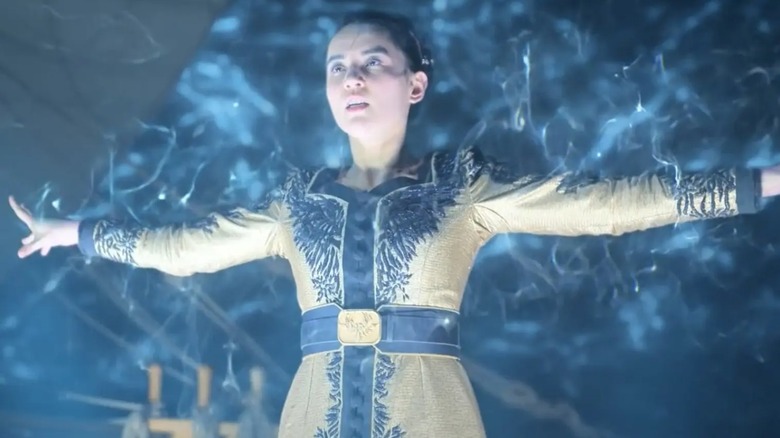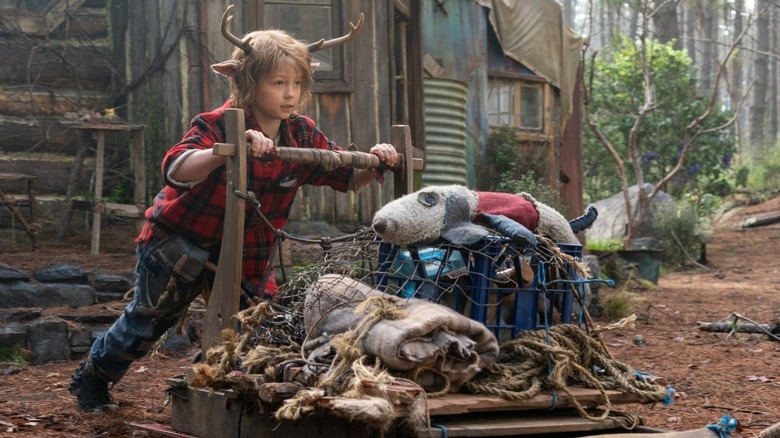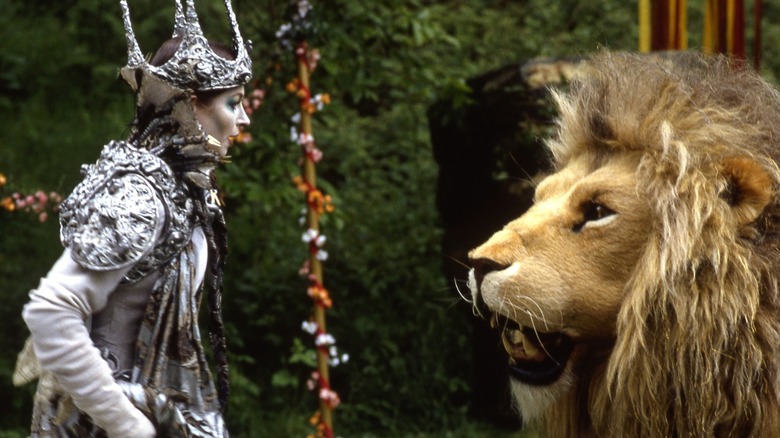14 Underrated Fantasy Shows That Deserve Your Attention
You've scaled the Wall in Westeros. You've crept past things older and fouler than orcs in the Mines of Moria. You've strolled through the unstable world of The Dreaming. You've immersed yourself in the magic of all these incredible — and incredibly famous — fantasy worlds. Now, you want something a little different.
Fantasy has evolved on television, offering much more than hackneyed hack-and-slashing and melodramatic magic that appeared in the half-baked miniseries and cartoons of the 20th century. That's not to say that all previous fantasy shows were bad, of course. British television expertly adapted literature classics, for example. However, the bar has clearly been raised, and modern streaming services now offer a nearly endless variety of fantasy series to explore.
In fact, there are now so many to choose from that some of these shows have inevitably fallen through the cracks. So, consider this list a gateway to new worlds — some that you may be aware of, and some that may be new to you. These are 14 fantasy shows that have been overlooked on streaming services, canceled before they truly blossomed, or forgotten over time. Give them another shot.
Arcane (2021-present)
You can name every great television show based on a video game in less time than it takes to load "Adventure" on the Atari 2600. There aren't many. The Netflix series "Arcane" defies the trend with its compelling story, stunning visuals, and gorgeous fight scenes. The nine-episode series depicts the origin stories for two "League of Legends" characters, but forget all that. Ignore the game behind the scenes. Focus only on what's on screen.
"Arcane" is about a region split into two warring societies — one thriving, one suffering — and the emergence of magical materials that could shift the balance of power. The city of Piltover succeeds because of cutting-edge science, while Zaun struggles because a reliance on chem-tech has thrust underground crime lords into power.
Despite the factions that control these societies, "Arcane" focuses on individuals, and shows how the decisions they make change the world they live in. As in "League of Legends," characters have their own ideals, their own goals, their own aesthetics, and their own fighting styles. Regardless, "Arcane" stands on its own as a story if, like me, you have no interest in the game.
Avatar: The Last Airbender (2005-2008)
Underrated? A show that won a Peabody Award and has legions of die-hard fans? That is correct. A generation of Nickelodeon viewers fell in love with "Avatar: The Last Airbender" when it debuted in 2005. But it's on this list because many people outside of that generation, particularly those who are older, likely resist watching because it's animated. Don't make that mistake. No matter what age you happen to be, "Avatar" remains one of the best fantasy stories ever put on screen.
"Avatar" focuses on a young monk named Aang who can bend air and other elements to his will. Not only is Aang last of his kind, but he must also deal with the pressures that come with being the legendary Avatar, and he just awoke from a state of suspended animation to find the world embroiled in a war against the fascist Fire Nation. So, yeah, he has a lot going on.
The character designs in "Avatar" mix anime with other influences. They're beautiful, but at times look too cartoonish. Don't be deceived by the childish imagery, though; the characters are young, but they confront grown-up problems like colonialism and genocide. However, despite being loaded with heavy themes, "Avatar: The Last Airbender" remains light and airy thanks to Aang's persistent optimism. He's a force for good who will obliterate your resistance to watching cartoons that are nearly 20 years old.
Beauty and the Beast (1987-1990)
What's brewing in the tunnels beneath New York City? Romance. "Beauty and the Beast" stole America's heart when it debuted in 1987, featuring Ron Perlman as the beast, Vincent, and Linda Hamilton as the beauty, Catherine Chandler (at least for two of its three seasons). She's a prominent attorney who is wounded, then found and cared for by the underworld beast, who introduces her to a community of cavern dwellers.
In most episodes, Chandler finds herself in mortal danger, only to be rescued by Vincent. The soft lens, sometimes corny dialogue, and procedural formula can be a little much, but there's something about the show that gives it some charm. It takes you to a world under ours that has unlimited possibilities, and introduces you to bizarre and intriguing characters. I'm not surprised that, despite its flaws, the series still works — creator Ron Koslow is the brains behind the comedy classic "Moonlighting," and its writers are responsible for episodes of hits like "24," "Homeland," and "Party of Five." One even wrote a book series you might have heard of: "A Song of Ice and Fire," which was adapted for TV as "Game of Thrones." Yes, George R. R. Martin wrote nine episodes of "Beauty and the Beast" — so, yeah, don't get too close to any of the characters.
Dungeons & Dragons (1983-1985)
I won't lie to you: In season one, "Dungeons & Dragons" can be corny as hell, thanks to its bland art, a basic story, and Eric the Cavalier's whiny voice. If you love the "Dungeons & Dragons" universe, though, you may want to give it a shot. Not many shows feature bullywugs and aarakocra. "Dungeons & Dragons" is about a group of kids who are transported into the world of the game and given magic items by the Dungeon Master. They're then hunted by an evil wizard who wants their weapons as they search for a way home.
In the second season, the series starts to build momentum as the story gains some depth and challenges its young characters to decide who they will become. Even Eric the Cavalier starts to become mildly tolerable. After a few episodes, don't be surprised to find yourself excited for the next installment when the rousing post-credits score kicks in.
Into the Badlands (2015-2019)
"Into the Badlands" is a martial arts fantasy set in a feudal post-apocalyptic wasteland. If you're like me, that's all you need to know. For the rest of you: "Into the Badlands" doesn't have creatures or magic, but there is a supernatural mythology behind the main protagonist, Sunny (Daniel Wu). His power is sometimes matched by those with dark chi, also known as "The Gift," including Sunny's new ward, M.K. Together, the two go on a journey to break free from their oppressors and learn more about who they are.
The world they travel in is post-apocalyptic, but it's not dark and grimy. Flowers are in bloom, and life is present. It's a wonderful backdrop for the action — and make no mistake, the action is the big draw here. "Into the Badlands" has some of the best fight sequences ever produced for American television. The choreography and skill on display are a type of magic unto themselves. Take this journey and you're sure to be leg swept onto the couch for a multi-episode binge.
Jonathan Strange & Mr. Norrel (2015)
In "Jonathan Strange & Mr. Norrel," magic has returned to England. Its power is used to fight wars and manipulate members of high society. However, true power, the kind that can bring a loved one back from the dead, is not controlled by man — it's wielded by dark fairies with sinister intentions, like the Gentleman, a creature that corrupts the lives of those who use its magic. In "Jonathan Strange & Mr. Norrel," the Gentleman enchants the loved ones of the titular magic users and transports them to another realm.
That's a lot of story for one paragraph, yet I've only scratched the surface of this fantastic series. The miniseries is based on a 782-page book, but the folks at the BBC managed to fit it all into just seven episodes. In spite of that density, "Jonathan Strange & Mr. Norrel" succeeds because it's constructed like a period piece set inside a house of mirrors. The script also works as both a gloomy drama and light comedy. Don't expect any Pythonesque bits, but the show does have a keen wit that keeps your spirit bright despite this world's suffocating darkness.
Lovecraft Country (2020)
"Lovecraft Country" is based on the works of a horror icon, but it has tendrils of fantasy that writhe throughout. As you probably guessed, the series leans heavily on H.P. Lovecraft's writing, but subverts one of his most repugnant traits: his overt racism. As /Film's own Chris Evangelista states, the series performs a "ritual cleansing" of that prejudice, reimagining racism as the greatest of its many terrors.
High fantasy is often about watching the oppressed stand up and resist despite the odds. Well, in "Lovecraft Country," our central fellowship of Chicagoans is more than ready to fight. Our heroes set out on a cross-country trek to find a lost loved one, armed with only a map that portends the horrors that might waylay them on their journey. See? It's fantasy — there are even swords, spells, and robed figures.
The acting in"Lovecraft Country" is on par with that of any series that HBO has aired. Jurnee Smollett in particular will cast a spell on you. She can conjure a sparkle, smolder, or raging inferno that burns through the screen, all in one closeup shot. There are continual surprises in this fantasy horror series; unfortunately, the biggest is that it came to an end after just 10 episodes. We're still praying to the old gods for more.
The Nevers (2021)
The following writeup contains spoilers for "The Nevers."
I once ordered an expensive steak for my birthday. It arrived covered in blue cheese. I never understood why the chef would smear bitter goop onto such a wonderful cut of meat. Well, Amalia True's storyline in "The Nevers" is a wonderful cut of meat that's smothered in bothersome subplots. When she's on screen, the show speeds forward. As soon as she steps out of frame, it grinds to a halt. Maybe if "The Nevers" focused more on her discovery of her powers — or just Amalia in general — it wouldn't have been canceled by Warner Bros.
Of course, the sixth episode reveal doesn't help, either. The whole "aliens are behind the magic" twist is not my bag. When "The Nevers" works, it shows off high-octane action scenes fueled by a rise in magic during the industrial revolution. Its effects are beautiful, and its sets and costumes are meticulously crafted. However, it's unclear what's in store for the final six episodes, which were left unaired — including whether or not we'll ever get to see them. Hopefully, they focus on the meat of the story and not the sides, although I'm certain we'll get an unhealthy helping of aliens along with the main course.
Over the Garden Wall (2014)
"Over the Garden Wall" offers delectable morsels of adventure that can be enjoyed in one sitting, depending on the size of your appetite. Over the course of 10 episodes, two half-brothers lost in a magical forest try to find their way home. Along their way, they meet charming denizens played by beloved actors, including Christopher Lloyd as the Woodsman and Melanie Lynskey as Beatrice, a talking bluebird.
The half-brothers, who are voiced by Elijah Wood and Collin Dean, exude charm. Wirt is the older brother who keeps his artistic pursuits quiet out of fear that he'll be teased. He's anxious while caring for his little brother, Greg, who is happy-go-lucky and armed with a nameless frog. There's a level of care to this story that remains from beginning to end, even extending to the concluding montage about the characters you've met along the way.
Primal (2019-present)
"Primal" is relatable. It's about the drive to survive after trauma, and the desire to share that experience with someone who's been through similar struggles. "Samurai Jack," which was also created by "Primal" mastermind Genndy Tartakovsky, had a similar concept, but its execution was very different. In "Primal," the pace is slower; in between fights, the show breathes like a loose loincloth. In addition, while "Samurai Jack" wasn't exactly full of unnecessary chatter, "Primal" has no dialogue at all. Instead, it lets its main characters' actions do the talking.
"Primal" is not your traditional fantasy. It has no pointy ears, and no flickering wands. However, its creatures show supernatural instincts, and the chieftain who wants revenge on our leads, Spear and Fang, in season 2 is powered by demonic forces. Just make sure to watch this one after the kids go down; it's full of heart, but that heart gets ripped out and soaks the screen with a blood-red spray. When you're tired of teenage witches and politicking wizards, check out "Primal." It's not like anything else out there.
Robin of Sherwood (1984-1986)
Despite the technological limits of '80s television, the ITV series "Robin of Sherwood" may be the best telling of the Robin Hood story that's ever been put on film. In this version, a pagan prophecy foretells Robin's destiny to become a legendary hero, inspiring him to resist the oppressive King of England and Sheriff of Nottingham.
The show's sets transport you to 12th century England with realistic costumes and locations. Even the few that appear to be lifted from London's West End don't feel out of place because the actors fill the space. Much of the series is shot like a stage play, but it works because the highly-trained actors understand how to present themselves to the lens, which is extra impressive given how long the directors sustain some shots.
Here, the magic of Sherwood Forest comes in many forms: prophecies, possessions, ritual sacrifices, and droll banter. Talk while watching, and you may miss the little bits of wit peppered throughout the script — the first known proof that the British enjoy seasoning. There are few to no special effects, but the handheld camera keeps the action moving during dramatic moments. The music is fantastic, too. Irish group Clannad released the soundtrack it recorded as its own album, "Legend," which reached number 15 on Britain's Official Charts. Stream this series, and one week later Spotify will be recommending you bands that also feature harps, mandolins, and tin whistles.
Shadow and Bone (2021-present)
"Shadow and Bone" is the greatest CW show that never aired on the CW. It's full of pretty people in grimy places doing outwardly stupid things for secretly good reasons. I am stunned that it's been picked up for season two on Netflix. I'm also happy. Some of the show's plot points are infuriating, like the master thief who runs an empire but is somehow penniless, or the muscle he employs, a master assassin and a master sharpshooter, who fail to protect him against his rivals. Or the overall smarminess. It's just ... so ... gah.
(Takes a deep breath. Brushes out cuffs. Straightens collar, despite wearing a t-shirt.)
With that out of the way, I admit there's a lot to like about "Shadow and Bone." We follow a cartographer who finds out she has the ability to control light, and that her power could destroy a shadowy strip of land that's separated the nation of Ravka for generations, leading to a civil war. Now that season one of "Shadow and Bone" has established the lore, characters, and overall premise, season two can cast some light on the parts of the series originally obscured by its attempts to attract the Insta-crowd. Hopefully, Netflix shows us it's stream-punk enough to give "Shadow & Bone" time to become more than just a pretty face.
Sweet Tooth (2021-present)
For those who haven't seen it before, "Sweet Tooth" is like a 100 Grand Bar. You've scrolled past the series on Netflix, but you've never taken a bite — and why would you? Sabrina, Geralt, and the Hellfire Club are right there. But I implore you to try this delicious treat. Its story is caramel-sweet, with crisp character arcs and rich settings, and it's all wrapped up in a post-apocalyptic fantasy world where children are becoming human-animal hybrids.
There is some violence, but most of your family can partake in the first eight episodes of the series. "Sweet Tooth" mostly focuses on Gus, a kid who seems to be part deer. After his father dies, Gus abides by his father's rules, which keep him safe in a dense forest compound. The problem? Gus has questions that he needs answered. His ensuing search connects several individuals of high moral character who don't want to give up on Gus, even if that's not always in their best interests. Grab a 100 Grand Bar, turn on "Sweet Tooth," and enjoy the sugar rush that follows.
The Lion, The Witch, and the Wardrobe (1988)
In 2005, "The Chronicles of Narnia: The Lion, the Witch, and the Wardrobe" tried to belly up to the big kids' table alongside "Harry Potter" and "The Lord of the Rings," but, despite receiving two sequels, could barely see its tea and crumpets. Meanwhile, the six-episode BBC adaptation of "The Lion, The Witch and the Wardrobe," which aired the better part of two decades earlier, succeeds because it doesn't try to be something it's not.
The miniseries plods along at a methodical pace, allowing you to breathe in the magic of Narnia — not that it's that magical. Most of the sets and costumes look like they're assembled from parts found in community theater storage units. Aslan moves and talks like a ShowBiz Pizza Place animatronic. The wildest scene may be the final battle, in which the main characters emulate the Star Wars Kid to fight hand-drawn creatures.
And yet, for the most part, it works. There's magic if you believe there is. The actors certainly do. No matter how preposterous the costumes or makeup are, they commit to their roles. Veteran genre actress Barbara Kellerman bursts with rage as the White Witch, and her horrific entourage elicits a high level of kindertrauma. Yes, "The Lion, The Witch and the Wardrobe" is a Christian parable that hits you over the head with its piousness, especially later in the series, but there's enough wonder to be found through this wardrobe to make the three-hour journey worth it.
